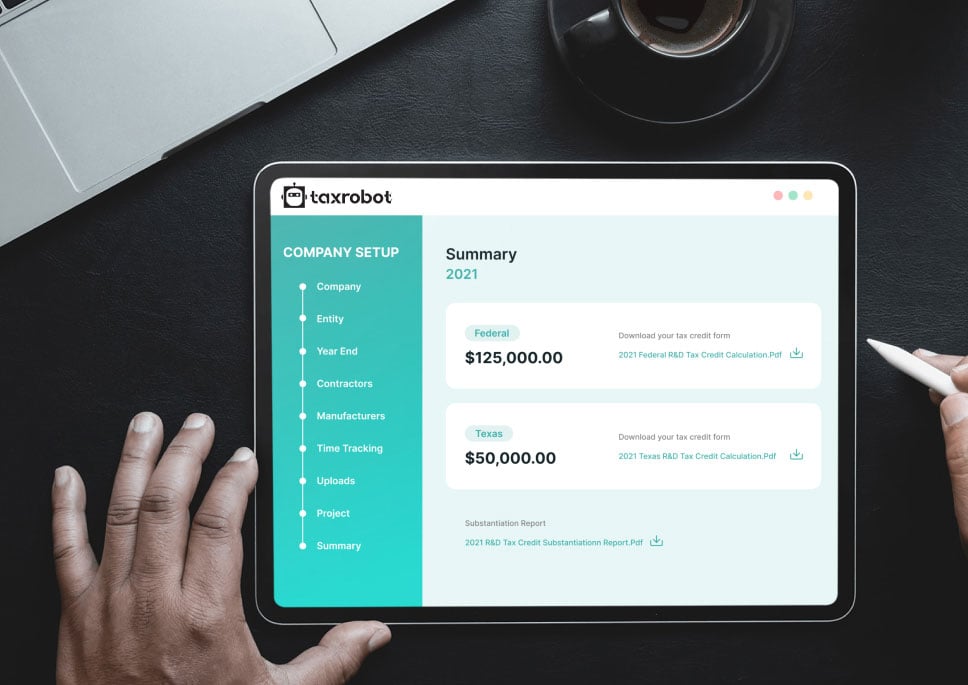New Jersey R&D Tax Credit
With TaxRobot, New Jersey R&D Tax Credit becomes more than a benefit—it becomes a catalyst for your business growth. Unleashing the incredible, simplifying the complex. This is not just tax planning; it’s financial evolution.
Maximize your State Credits today!
Put the R&D tax credit process on autopilot.
Trusted By:








New Jersey R&D Tax Credit
Discover your eligibility for New Jersey R&D tax credits and supercharge your enterprise.
Simplify Your New Jersey R&D Tax Credit Process with TaxRobot
Welcome to the world of R&D tax credits in New Jersey, where innovation meets tax benefits.
Are you ready to unlock the potential of your research and development activities?
Look no further than TaxRobot, your trusted AI-powered companion in navigating the complexities of R&D tax credits. With our cutting-edge software, we simplify the process, ensuring maximum refunds and minimal hassle.
New Jersey’s R&D Tax Credit, leveraging federal section 41 rules with modifications, offers a golden opportunity for corporations to claim credits against their entire net income.
Let TaxRobot be your guide as we dive into the exciting realm of R&D tax credits in the Garden State.
Understanding the New Jersey R&D Tax Credit
Welcome to the New Jersey R&D Tax Credit realm, where innovation and tax savings collide. This credit, built upon the foundations of federal section 41 rules with unique modifications, offers an enticing opportunity for businesses to supercharge their research activities.
In the Garden State, eligible C-Corporations, and in rare cases, S-Corporations, can claim this credit against their entire net income. It’s important to note that partnerships and other pass-through entities aren’t eligible.
The credit is roughly 10% of the excess of qualified research expenses (QREs) over the base amount. Unused credits can be carried forward for up to 7 years, while specific industries enjoy an extended 15-year carryforward period.
At TaxRobot, we understand the intricacies of this credit, and our software is here to help you unlock its full potential.
How TaxRobot Works
Discover the simplicity and efficiency of TaxRobot. Our software streamlines the process of claiming the New Jersey R&D Tax Credit, making it easier than ever before.
With TaxRobot, you can enjoy a seamless three-step process: provide the necessary information, link your systems, and receive your refund. Our AI-powered algorithms work tirelessly to accurately calculate your qualified research expenses, saving you time and effort.
Let TaxRobot handle the intricacies of the R&D tax credit process, allowing you to focus on running your business.
Experience the convenience and effectiveness of TaxRobot as we guide you toward maximizing your New Jersey R&D tax credits.
Time-Saving Automation and Documentation
Say goodbye to tedious paperwork and manual calculations. With TaxRobot, you can harness the power of time-saving automation. Our software is designed to streamline the R&D tax credit process, freeing your valuable time.
Let our algorithms handle the calculations, ensuring accuracy and efficiency. Meanwhile, our superior documentation satisfies statutory and IRS-recommended reporting requirements, providing peace of mind.
With TaxRobot by your side, you can focus on what matters most – running your business – while we take care of the documentation and save you precious time along the way.
Value-Based Pricing and Audit Support
At TaxRobot, we believe in value-based pricing and putting our clients’ interests first. We only charge a fee if you receive a tax credit – no hidden costs or surprises.
We stand by the quality of our work and offer audit support, ensuring you have peace of mind throughout the process. In the event of an audit, we’re here to handle questions and requests, providing you with the support you need.
Experience the transparency and reliability of TaxRobot as we navigate the R&D tax credit landscape together.
Simplify and Maximize Your New Jersey R&D Tax Credits with TaxRobot
TaxRobot is your trusted partner in navigating the complexities of the New Jersey R&D Tax Credit. Our AI-powered software simplifies the process, allowing you to claim every dollar you deserve.
With TaxRobot, you can maximize your R&D tax credits, leveraging our expertise and time-saving automation. We provide superior documentation that satisfies regulatory requirements, ensuring compliance and audit-proof claims.
Trust our value-based pricing model and audit support to give you peace of mind. Take advantage of the potential tax benefits available to your business.
Take a sneak peak

- Limited Time Offer
- Simple Onboarding
- Easy to Use
R&D Tax Credits FAQs
The four-part test as outlined in the Internal Revenue Code is used to determine qualified R&D activity.
The Four-Part Test
1). New Or Improved Business Component
Creation of a new product, process, formula, invention, software, or technique; or improving the performance, functionality, quality, or reliability of existing business component.
- Construction of new buildings or renovation of existing buildings
- Invention of a software application
- Manufacturing of a new product or the improvement of the production process for an existing product
- Creation of design documentation
2). Technological In Nature
The activity fundamentally relies on principles of the physical or biological sciences, engineering, or computer science. A taxpayer does not need to obtain information that exceeds, expands or refines the common knowledge of skilled professionals in a particular field.
- Physics (relationship between mass, density and volume; loading as the
result of gravitational attraction) - Engineering (mechanical, electrical, civil, chemical)
- Computer science (theory of computation and design of computational systems)
3). Elimination Of Uncertainty
Uncertainty exists if the information available to the taxpayer does not establish the capability or method for developing or improving the business component, or the appropriate design of the business component.
- The capability of a manufacturer to create a part within the specified tolerances
- The appropriate method of overcoming unsuitable soil conditions during construction
- The appropriate software design to meet quality and volatility requirements
4). Process Of Experimentation
A process designed to evaluate one or more alternatives to achieve a result where the capability or method of achieving that result, or the appropriate design of that result, is uncertain as of the beginning of the taxpayer’s research activities.
- Systematic process of trial and error
- Evaluating alternative means and methods
- Computer modeling or simulation Prototyping Testing
The R&D tax credit is one of the most misunderstood tax incentives available. Considering the myriad of industries and activities that legally qualify for the credit, the term “research and development” is a misnomer. Additionally, the R&D tax credit requires specialized knowledge and technology to identify and calculate the incentive properly.
Companies of various industries are unaware that they are eligible to claim the R&D tax credit. Under the Internal Revenue Code’s definition of R&D, many common activities qualify. You can get tax benefits for industries including software, technology, architecture, engineering, construction, manufacturing, and more.
The R&D tax credit can be claimed for all open tax years. Generally, open tax years include the prior three tax years due to the statute of limitations period. In certain circumstances, the law allows businesses to claim the R&D tax credit for an extended period of time. It is common for companies to amend previous tax years to claim this benefit and reduce the maximum amount of tax liability.
Partnerships and S corporations must file this form to claim the credit. The credit will flow from the Form 6765, to the Schedule K-1, to the Form 3800 on the individual’s tax return. For individuals receiving this credit that have ownership interest in a partnership or S corporation, Form 6765 is not required on the individual return.
Individuals claiming this credit can report the credit directly on Form 3800, General Business Credit if their only source for the credit is a partnership, S corporation, estate, or trust. Otherwise, Form 6765 must be filed with the individual’s tax return (e.g. sole proprietorship).
For tax years prior to 2016, the credit can be used to reduce the taxpayer’s regular tax liability down to the tentative minimum tax. The credit cannot be used to offset alternative minimum tax. Beginning in tax year 2016, eligible small businesses have expanded utilization for the credit. For these eligible small businesses, the regular tax liability can offset alternative minimum tax using the “25/25” rule.
What our customers have to say
I highly recommend TaxRobot to anyone considering an R&D Tax Credit software to complete their analysis.

We decided to switch to TaxRobot… Best decision we’ve ever made. More affordable, and less complicated.

I couldn’t believe how easy it was! In under an hour, we saved enough money to hire a new employee.
